How Does the Houston Museum of Art Compare With Other Fina Arts Museums
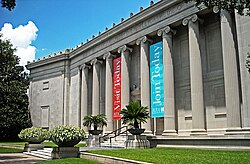 Watkin Building | |
 | |
| Established | 1900 |
|---|---|
| Location | 1001 Bissonnet Houston, TX 77005 United States |
| Coordinates | 29°43′32.v″Northward 95°23′25.v″W / 29.725694°N 95.390417°West / 29.725694; -95.390417 Coordinates: 29°43′32.5″Due north 95°23′25.5″W / 29.725694°Due north 95.390417°Westward / 29.725694; -95.390417 |
| Type | Art Museum, Institute, Library, Sculpture Park[i] |
| Manager | Gary Tinterow |
| Public transit admission | Red Line |
| Website | www |
The Museum of Fine Arts, Houston (MFAH), is an art museum located in the Houston Museum Commune of Houston, Texas. It is one of the largest art museums in the United States. With the recent completion of an eight yr campus redevelopment project, including the opening of the Nancy and Rich Kinder Building in 2020, it is the twelfth largest art museum in the world based on square feet of gallery space.[ii] The permanent collection of the museum spans more than 6,000 years of history with approximately 70,000 works from half dozen continents.[three]
Facilities [edit]
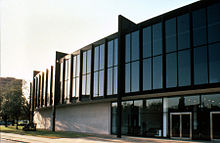
Caroline Wiess Law Building
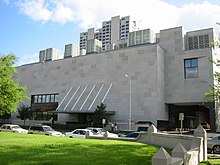
Audrey Jones Beck Edifice

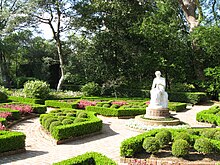
Gardens at Bayou Bend, donated by Ima Hogg
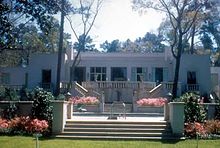
The MFAH's permanent collection totals nearly 70,000 pieces in over 300,000 square feet (28,000 thousand2) of exhibition space,[4] placing it amid the larger art museums in the United States. The museum's collections and programs are housed in nine facilities. The Susan and Fayez Southward. Sarofim Campus encompasses 14 acres including seven of the facilities, with ii additional facilities, Bayou Bend and Rienzi (firm museums) at off site locations. The main public collections and exhibitions are in the Police, Beck, and Kinder buildings.[five] [six] The Police and Beck buildings have over 130,000 square anxiety (12,000 m2) of exhibition space.[7]
The Susan and Fayez S. Sarofim Campus [edit]
- Caroline Wiess Law Building – the original neo-classical building was designed in phases by architect William Ward Watkin. The original Caroline Wiess Law building was constructed in 1924 and the east and due west fly were added in 1926. The Robert Lee Blaffer Memorial Fly was designed by Kenneth Franzheim and opened to the public in 1953. The new construction included significant structural improvements to several existing galleries—most notably, air conditioning. 2 subsequent additions, Cullinan Hall and the Brown Pavilion, designed past Ludwig Mies van der Rohe were built in 1958 and 1974 respectively. This department of the Museum of Fine Arts, Houston campus is the only Mies-designed museum in the United States. The Caroline Wiess Law building provides an platonic infinite in which to exhibit temporary and traveling exhibitions, likewise as installations of Islamic art, Pacific Island and Australian art, Asian art, Indonesian golden artworks, and Mesoamerican and sub-Saharan African art. Of special involvement is the Glassell Collection of African Gilded, the largest assemblage of its kind in the globe.[8] Besides the Nidhika and Pershant Mehta Arts of India, the merely space in Houston for Indian Arts Civilization.[ix]
- Audrey Jones Brook Building – Opened to the public in 2000, the Brook Building was designed by Rafael Moneo, a Pritzker Compages Prize Laureate.[x] The museum Trustees elected to proper name the building later Audrey Jones Beck in honor of the large collection she had donated to the museum several decades prior. In addition to traveling exhibitions and rotating temporary shows of photography, prints and drawings on the lower levels, the building displays the permanent collections of antiquities, European, and American art up to 1900, including the Impressionist.
- Nancy and Rich Kinder Building – In 2012, the museum selected Steven Holl Architects to blueprint a 164,000 sq ft (15,200 thoutwo) expansion[11] that primarily holds galleries for art afterwards 1900. Opened to the public in Nov 2020, the new building occupies a two-acre site north of the Caroline Wiess Law Building. The new MFAH building is next to Lillie and Hugh Roy Cullen Sculpture Garden and an expanded Glassell School of Art. In addition to a theater, restaurant, café, and seven minor gardens and reflecting pools inset forth the edifice's perimeter, the 237,213 square-foot Kinder building increases the museums overall exhibition space by nearly 75 percent. In 2021, The Breastwork Collection opened Le Jardinier, a gimmicky French eatery emphasizing the highest-quality, seasonal ingredients from Michelin-starred chef Alain Verzeroli, and Italian-inspired Cafe Leonelli.[11] [12] [13]
- The Lillie and Hugh Roy Cullen Sculpture Garden – was designed by United states-born artist and landscape architect Isamu Noguchi and opened in 1986. The Lillie and Hugh Roy Cullen Sculpture Garden houses more xx-five works by artists from the nineteenth, twentieth, and 20-first centuries from the MFAH and other major collections.
- Glassell Schoolhouse of Fine art – founded in 1979 and designed by architect Due south. I. Morris, the Glassell School of Fine art offers programs under the Studio School for Adults. The Glassell School of Fine art serves as the didactics wing of the MFAH, with a variety of classes, workshops, and educational opportunities for students diverse in historic period, interests, experience, and needs. In 2014, Steven Holl designed a new L-shaped building for the school, featuring a ramped amphitheatre that leads upwards to a walkable rooftop garden.[11] In addition to opening onto Noguchi'southward sculpture garden and providing added outdoor space for programs and performances, the fourscore,000 sq ft (7,400 yardii) building also sits atop an all-encompassing underground parking garage.[11] The school offers classes at the Studio Schoolhouse for Adults and the Glassell Inferior Schoolhouse, likewise every bit Community Span Programs, special programs for youths, and the Core Creative person-in-Residence Programme.
- Key Administration and Glassell Junior School of Art Building – The building, opened in 1994 and designed by Texan architectural designer Carlos Jimenez, houses the museum's administrative functions as well as the Glassell Junior School. The MFAH is the only museum facility in the United States that has a special building defended solely to art classes for children.[14]
- The Sarah Campbell Blaffer Foundation Center for Conservation – is a 37,864-foursquare-foot conservation middle designed by Lake-Flato Architects that was completed in 2018. It is abode to conservation labs and studios located in a higher place the museum's parking garage. It is non open up to the public.[xv]
Other Facilities [edit]
- Bayou Bend Drove and Gardens – features a collection of American decorative art and furniture. The Bayou Bend Collection and Gardens, erstwhile home of Life Trustee Ima Hogg, was designed past architect John F. Staub in 1927. Miss Hogg donated the property to the MFAH in 1957, followed, in 1962, by the donation of its collection of paintings, furniture, ceramics, glass, metals, and textiles. Bayou Bend was officially dedicated and opened to the public in 1966. Situated on fourteen acres (57,000 thou2) of formal and woodland gardens five miles (8 km) from the main museum campus, the historic house museum documents American decorative and fine arts from the seventeenth to the mid-nineteenth centuries.
- Rienzi – the MFAH house museum for European decorative arts, Rienzi was donated to the MFAH by Carroll Sterling Masterson and Harris Masterson III in 1991. The residence, named for Rienzi Johnston, Mr. Masterson'due south grandad, is situated on iv.4 acres (18,000 m2) in Homewood Addition, surrounded past Houston's River Oaks neighborhood. The construction was designed in 1952 by John F. Staub, the same architect who designed Bayou Curve. Completed in 1954, Rienzi served as both a family home and a center for Houston borough and philanthropic action from the 1950s through the mid-1990s. Later Mr. Masterson'southward death, the MFAH transformed the home into a museum and afterwards opened information technology to the public in 1999.[xvi]
History [edit]

The Museum of Fine Arts, Houston (MFAH) is the oldest fine art museum in Texas. In 1917, the museum site was dedicated by the Houston Public School Art League (later the Houston Fine art League) with the intention of condign a public art museum. The get-go museum building was opened to the public in 1924. The original building, designed by Houston architect William Ward Watkin in the Greek Neoclassical way, is the first art museum congenital in Texas. Today the MFAH encompasses two buildings, the Caroline Wiess Law and Audrey Jones Beck buildings, that house its principal collections and temporary exhibitions; ii decorative arts house museums; The Glassell studio art schoolhouse; a sculpture garden; a facility for conservation, storage and archives; and an administrative building with the Glassell Junior school of Art.
Prior to the opening of the permanent museum edifice in 1924, George Yard. Dickson bequeathed to the drove its first important American and European oil paintings. In the 1930s, Houstonian Annette Finnigan began her donation of antiquities and Texas philanthropist Ima Hogg gave her collection of avant-garde European prints and drawings. Ima Hogg'southward gift was followed by the subsequent donations of her Southwest Native American and Frederic Remington collections during the 1940s. The same decade witnessed the 1944 heritance of fourscore-three Renaissance paintings, sculptures and works on paper from renowned New York collectors Edith and Percy Straus. Over the next two decades, gifts from prominent Houston families and foundations full-bodied on European art from the fifteenth to twentieth centuries, contemporary painting and sculpture, and African, Oceanic and Pre-Columbian fine art. Amid these are the gifts of Life Trustees Sarah Campbell Blaffer, Dominique de Menil and Alice N. Hanzsen as well every bit that of the Samuel H. Kress Foundation. Augmented by museum purchases, the permanent collection numbered 12,000 objects past 1970.

The MFAH collection nearly doubled from 1970 to 1989, fueled past continued donations of art along with the appearance of both accession endowment funding and corporate giving. In 1974, John and Audrey Jones Beck placed on long-term loan fifty Impressionist and Post-Impressionist masterpieces, augmenting the museum's already potent Impressionist collection. This drove would never go out the MFAH, formally entering its holdings in 1998 as a souvenir of Life Trustee Audrey Jones Brook. The collection is permanently displayed in the building that bears her name. On the heels of the Cullen Foundation's funding of the MFAH'due south kickoff accessions endowment in 1970, the Brown Foundation, Inc., launched a challenge grant in 1976 that would stay in effect for twenty years raising funds for both accessions and operational costs in landmark amounts and providing incentive for additional community support. As well in 1976, the photography drove was established with Target Stores' outset corporate grant to the museum. Today the museum is the 6th-largest in the country.[17]
In 2001, the MFAH, established the International Middle for the Arts of the Americas (ICAA), the leading research institute for 20th-century Latin American and Latino art. The ICAA has been a pioneer in collecting, exhibiting and researching the diverse artistic production of Latin American and Latinx communities, including artists from Mexico, Central and South America, the Caribbean, and artists of Latin American descent living and working in the United States. Through the ICAA, the MFAH brought a long-term transformation in the appreciation and agreement of Latin American and Latinx visual arts in the United States and away.<ref="nytimes.com">Hilarie M. Sheets (Nov 13, 2020), [1]'
Drove [edit]
With approximately 70,000 works of art, the largest part of the museum's collection lie in the areas of Italian Renaissance painting, French Impressionism, photography, American and European decorative arts, African and pre-Columbian golden, American fine art, and post-1945 European and American painting and sculpture. Other facets of the collection include African-American art and Texas painting. Emerging drove interests of mod and gimmicky Latin American fine art, including the artwork of all Texas Latino artists, Asian art, and Islamic fine art continue to strengthen the museum'south drove diversity. As a result of its encyclopedic collection, the museum ranks nationally among the top ten art museums in attendance.[eighteen]
Since 2019 Hossein Afshar Collection, one of the world's most distinguished private collections of Persian fine art, is on loan to MFAH. The museum has organised ii exhibitions of this collection.[nineteen]
Claim for restitution [edit]
In 2021 the Monuments Men Foundation appear that information technology had located a painting from the collection of Max Emden in the Museum of Fine Arts, Houston (MFAH).[twenty] Co-ordinate to the Foundation, the painting by Bernardo Bellotto, chosen The Market at Pirna, had an inaccurate provenance that concealed the history of the painting.[21] [22] Afterwards the MFAH refused to restitute the painting the Emden heirs filed a lawsuit in the Southern District of Texas.[23] [24]
The Museum, which had rejected the Emden heirs' claims since 2007, disagreed with the characterization of the painting as having been subject to a forced or duress sale due to Nazi persecution. MFAH managing director Gary Tinterow stated that Emden sold the painting voluntarily and, that after consulting provenance and legal experts, "we ended that we had expert title."[25] The museum also states that the Bellotto is one of multiple near identical versions by the creative person, and was bought by Samuel H. Kress in 1952 and later donated to the museum in 1961.[26]
Galleries [edit]
Arts of Oceania, Africa, & the Americas [* = mixed media: ** = painted wood: *** = earthenware]
Arts of Asia and the Islamic Earth
-

Bian Shoumin, Wild Geese on Sandbank (1730), ink on paper, 132.1 × 70.2 cm.
-

Kishi Ganku (Japan), Tiger in Landscape (1770-1839), ink and watercolor on paper, 171.2 × 372.1 × 1.5 cm.
-

Indian, Rama, Lakshmana, and Sita Cooking and Eating in the Wilderness (c. 1820), gouache & gold on paper, 21.6 × sixteen.5 cm.
Antiquities
European and American painting (1400-1899) [all oil on canvas except: ** = tempera & gold leaf on panel; * = oil on console]
-

Fra Angelico, Saint Anthony Abbot Shunning the Mass of Gold ** (c. 1435–1440), 19.seven x 28.1 cm.
-

Giovanni di Paolo, Saint Clare Rescuing a Child Mauled by a Wolf ** (c.1453-1462), 20.628.1 cm.
-

-

Jacopo Bassano, Christ in the Business firm of Mary, Martha, and Lazarus (c.1577), 98.4 × 126.4 cm.
-
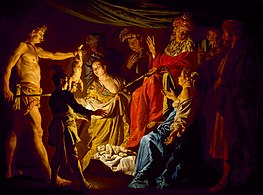
-

January Weenix, Yet Life of Game including a Hare, Blackness Grouse, Partridge, Spaniel, and Dove in Flying (c. 1680), 157.2 × 182.two cm.
-

-

Impressionism, postimpressionism, and early modern art [all oil on canvass unless noted otherwise]
-
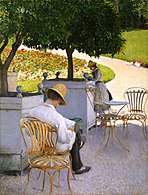
-

Paul Cézanne, Madame Cézanne in Blue (1888-1890), 74.1 × 61 cm.
-
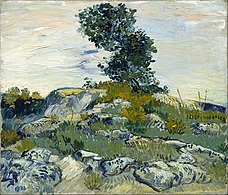
Vincent van Gogh, The Rocks (1888), 54.9 × 65.7 cm.
-
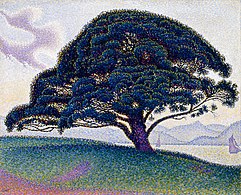
Paul Signac, The Bonaventure Pine (1893), 65.7 × 81 cm.
-
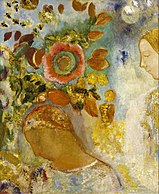
Odilon Redon, Two Young Girls among Flowers (1912), 62.2 x 51.4 cm.
-
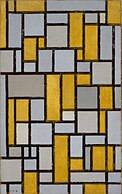
Management [edit]
Philippe de Montebello directed the museum from 1969 to 1974.[27] During the 28-year tenure of Peter Marzio between 1982 and 2010, the Museum of Fine Arts' yearly attendance increased to roughly two meg from 300,000; its operating budget climbed to $52 one thousand thousand from $5 million, and its endowment reached $1 billion[17] (earlier the 2008 recession dropped its value to virtually $800 1000000).[27] The museum's permanent drove more than tripled in size, to 63,000 works from 20,000.[28] In 2010, Marzio was the sixth-highest-paid charity main executive in the country, with bounty in 2008 of $i,054,939.[17] A twelvemonth after Peter Marzio died in 2010, Gary Tinterow was appointed equally the museum's director.[29] Mari Carmen Ramírez is a Puerto Rican Art curator and the Wortham Curator of Latin American Fine art at the Museum of Fine Arts, Houston.[ commendation needed ]
See also [edit]
- Bayou Bend Collection and Gardens
- Ima Hogg
- Samuel Henry Kress
- Listing of near-visited museums in the United states of america
- Listing of claims for restitution for Nazi-looted art
Notes [edit]
- ^ The Museum of Fine Arts, Houston: Virtually, ARTINFO, 2008, retrieved 2008-07-23 [ permanent dead link ]
- ^ The Museum of Fine Arts, Houston: Campus Redevelopment, The Susan and Fayez S. Sarofim Campus (accessed nineteen October 2021)
- ^ "Major Expansion of the Museum of Fine Arts, Houston Moves Forward with the Construction of the Audrey Jones Beck Building". Tfaoi.com. 1924-04-12. Retrieved 2012-09-xix .
- ^ "Tips for Visiting - The Museum of Fine Arts, Houston". mfah.org . Retrieved 23 May 2018.
- ^ "Museum of Fine Arts: Sarofim (main) Campus". mfah.org . Retrieved 24 December 2020.
- ^ "Museum of Fine Arts: The Nancy and Rich Kinder Building". mfah.org . Retrieved 22 December 2020.
- ^ ""Ontologically, every thing is unique": Behind the Mantle at the MFAH - OffCite Blog". offcite.org. 16 July 2015. Archived from the original on 22 August 2016. Retrieved 5 Apr 2018.
- ^ The Museum of Fine Arts, Houston. "The Glassell Collections". Mfah.org. Archived from the original on 2011-02-ten. Retrieved 2012-09-19 .
- ^ Villarreal, Ignacio. "Museum of Fine Arts in Houston Opens Nidhika and Pershant Mehta Arts of Republic of india Gallery". artdaily.com . Retrieved 5 Apr 2018.
- ^ "The Hyatt Foundation". Pritzkerprize.com. Archived from the original on 2011-12-09. Retrieved 2012-09-xix .
- ^ a b c d Pei-Ru Keh (Jan 19, 2015), Steven Holl Architects' dramatic expansion design for The Museum of Fine Arts in Houston Wallpaper.
- ^ Museum of Fine Arts, Houstom: Sarofim Campus (accessed 24 December 2020)
- ^ Robin Pogrebin (February vii, 2012), Houston Museum Chooses Architect for Expansion Plan New York Times.
- ^ The Museum of Fine Arts, Houston. "Glassell Junior School". Mfah.org. Retrieved 2012-09-xix .
- ^ "Museum of Fine Arts, Houston: Campus Redevelopment". mfah.org . Retrieved 24 December 2020.
- ^ The Museum of Fine Arts, Houston. "Rienzi". Mfah.org. Retrieved 2012-09-19 .
- ^ a b c Rebecca Southward. Cohen (April ix, 2011), Replacing a Museum Director Who Was a Rare Find New York Times.
- ^ The Museum of Fine Arts, Houston: Collections (accessed 24 December 2020)
- ^ Between Bounding main and Sky: Blueish and White Ceramics from Persia and Across
- ^ Cascone, Sarah (2021-08-eighteen). "Restitution Experts Nail Houston'due south Museum of Fine Arts for Refusing to Return a Painting Once Purchased for Hitler's Museum". Artnet News . Retrieved 2021-10-17 .
- ^ Edsel, Robert (2021-08-31). "The Museum of Fine Arts, Houston Must End Its Caput-in-the-Sand Approach to Justice When It Comes to Restitution". Artnet News . Retrieved 2021-ten-17 .
- ^ Villa, Angelica (2021-07-22). "MFA Houston Owns Bellotto Painting Sold Under Duress During Earth War II, Foundation Claims". ARTnews.com . Retrieved 2021-ten-17 .
- ^ "Emden et al 5. The Museum of Fine Arts, Houston". www.law360.com . Retrieved 2021-10-17 .
- ^ Cascone, Sarah (2021-ten-19). "The Heirs of a Jewish Collector Are Suing the Museum of Fine Arts, Houston, for the Render of a Bellotto Painting". Artnet News. Archived from the original on 2021-10-19. Retrieved 2022-01-26 .
- ^ Hickley, Catherine (2021-08-17). "What Constitutes Art Sales Under Duress? A Dispute Reignites the Question". The New York Times. ISSN 0362-4331. Archived from the original on 2021-09-02. Retrieved 2022-01-26 .
But the Museum of Fine Arts, Houston, which ultimately came to possess the third Bellotto, has rejected the Emden heirs' claims since 2007. Its director, Gary Tinterow, argues that Emden sold the painting voluntarily and, that afterward conducting provenance inquiry and consulting lawyers, "we concluded that we had good title."
- ^ Museum of Fine Arts, Houston. MFAH Backgrounder and Statement: "The Marketplace at Pirna," c. 1764, Bernardo Bellotto. (accessed 17 October 2021)
- ^ a b Douglas Britt (December 12, 2010), Peter Marzio, 67; transformed Houston museum Houston Relate.
- ^ William Grimes (December xi, 2010), Peter Marzio, Houston Museum Director, Dies at 67 New York Times.
- ^ Ballad Vogel (December ane, 2011), Met Veteran Named Managing director of Houston Art Museum New York Times.
External links [edit]
- Official website
- Photographs from the Museum of Fine Arts, Houston, hosted by the Portal to Texas History.
- International Center for the Arts of the Americas at MFAH
- The Museum of Fine Arts, Houston - The Adolpho Leirner Drove of Brazilian Constructive Art at Google Cultural Constitute
peltierthenizeena.blogspot.com
Source: https://en.wikipedia.org/wiki/Museum_of_Fine_Arts,_Houston
0 Response to "How Does the Houston Museum of Art Compare With Other Fina Arts Museums"
Post a Comment